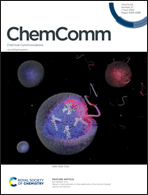Recent improvements to the selectivity of extraction-based optical ion sensors
Abstract
Optical sensors continue to demonstrate tremendous potential across a wide range of applications due to their high versatility and low cost. This feature article will focus on a number of recent advances made in improving the performance of extraction-based optical ion sensors within our group. This includes the progress of anchored solvatochromic transduction to provide pH and sample volume independent optical responses in nanoemulsion-based sensors. A recent breakthough is in polyion sensing in biological fluids that uses a novel indirect transduction mechanism that significantly improves the selectivity of dinonylnaphthalenesulfonate-based protamine sensors and its potential applications beyond polyion sensing. The role of particle stabilizers in relation to the response of emulsified sensors is shown to be important. Current challenges in the field and possible opportunities are also discussed.



 Please wait while we load your content...
Please wait while we load your content...